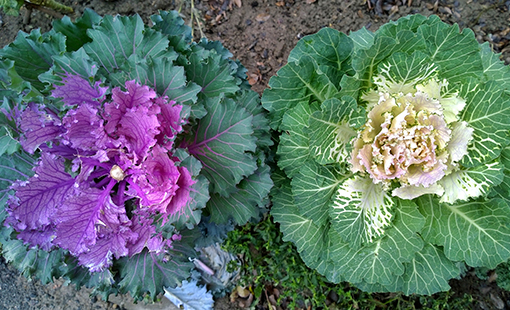
Planting Ornamental Kale and Cabbage
Ornamental cabbage and kale look and grow very much like their close relatives, the edible cabbages and kales. Although they’re categorized as the same species (Brassica oleracea) as the edible varieties and can be eaten, these ornamental cultivars have been bred for looks, not flavor. They are slightly bitter, though are often used as a garnish. Their leaves form rosettes of purple, rose and creamy white colors, making them look more like large flowers than vegetables.
In the trade, the varieties with smooth leaf margins and broad, flat leaves are generally referred to as flowering cabbages, while those with serrated or fringed leaf margins are considered flowering kales. (Technically, both are kales, because kale has leaves that form rosettes while a true cabbage has leaves that form a head.)
Ornamental cabbage and kale are cool-season biennials planted in the fall. This means they grow their vegetative leaves the first year and then send up flowers the second year, producing seeds before the plant dies. However, these plants are usually grown as annuals for their showy foliage, then removed from the garden.
Care
Ornamental cabbage and kale look especially good in a large grouping or as edging for a garden bed, where their purplish hues blend well with other fall colors. Growing the ornamental versions is not much different from growing regular cabbage or kale.
These are cool-season plants that are usually grown in the fall or early spring, discarded as the weather turns very cold or as the warm summer months arrive. These fast-growing plants can be started from seeds for either spring or summer growth, but are often planted from potted nursery starts.
Light
The plants prefer to grow in full sun. However, when grown in warmer climates, partial afternoon shade is ideal.
Soil
An organically rich, loamy soil that drains well is ideal for these plants. Both cabbage and kale prefer a slightly acidic soil pH of about 5.5 to 6.5.
Water
Keep the plants well-watered; they like soil that’s consistently moist but not soggy. If the top inch of soil is dry, it’s time to water. If your usual climate includes regular rain, you probably won’t have to water at all. But be prepared to add supplemental water during a dry spell.
Temperature & Humidity
Ornamental cabbage and kale don’t develop their full colors unless they get a good chill from a frost. They can last throughout the winter, but their appearance depends a lot on the weather. If it’s hot with long daylight exposure, they will bolt (send up a flower stalk and go to seed). And if it’s very wet with harsh storms, the plants will quickly become tattered. They can survive as long as temperatures remain above 5 degrees Fahrenheit. However, a sharp drop in temperature can damage or kill plants.
Humidity typically isn’t an issue for these plants. But if the weather is damp and the plants don’t have good air circulation, they might develop fungal diseases, which can appear as spots on the leaves.
Fertilizer
Fertilize ornamental cabbage and kale only at planting time using a balanced fertilizer. Don’t fertilize while they’re growing, or they can lose color and get leggy.
Varieties
Unless you are growing commercially, there’s not much variety to choose from when it comes to ornamental cabbage and kale. Most seed packets are simply labeled “ornamental cabbage.” So it’s best to focus on a color combination that appeals to you. Flowering kales can be divided into “fringed-leaved cultivars” (those with ruffled leaves) and “feather-leaved cultivars” (those with finely serrated leaves).
Some popular varieties include:
- ‘Chidori’ ornamental kale: This plant has very curly leaf edges with leaves that are purple, creamy white, or deep magenta.
- ‘Color Up’ ornamental cabbage: This grows upright with green leaves and centers of white, pink, or fuchsia.
- ‘Osaka’ ornamental cabbage: This ornamental cabbage has large, smooth leaves with center colors of pink, red, or white. The plant typically stays compact.
- ‘Peacock’ ornamental kale: This plant looks more like its edible kale cousins, with loose growth and deeply serrated leaves in red, purple, or white.
- ‘Pigeon’ series ornamental cabbage: This variety has a flattened shape with red or white centers.
Potting and Repotting
If you only want one or two plants, ornamental cabbages or kales often look more natural when grown in containers rather than scattered throughout a garden. They can make nice seasonal potted plants, much the way that potted pansies are used in the spring, and potted chrysanthemums in the fall.
Choose a container with ample drainage holes, and use an all-purpose potting mix. Nursery plants likely won’t grow much larger than they are when you get them, so you typically won’t have to worry about repotting into a larger container.
Common Pests & Diseases
Like many edible vegetables in the Brassica genus, ornamental cabbages and kales are quite susceptible to cabbage worms, cabbage loopers, flea beetles, caterpillars, thrips, slugs, and aphids. Hard water sprays can be used to dislodge many of these pests. A variety of pesticide dusts or horticultural oils designed for vegetables will also work on these pests.
Common disease problems include leaf spots, blackleg, black rot, and yellows. These are most likely to occur when conditions are very damp.
Cabbages and kales planted in pots may be less susceptible to pests and diseases than those planted in the garden.
Information courtesy of TheSpruce.com

 Adams Fairacre Farms
Adams Fairacre Farms